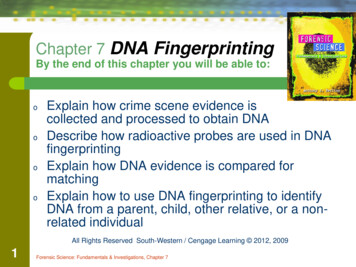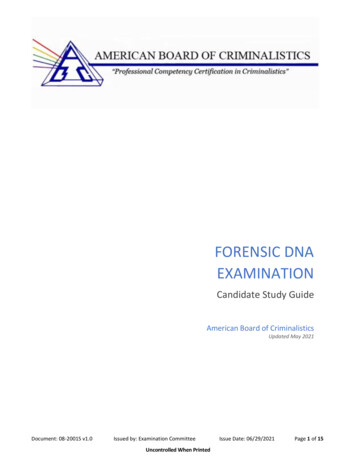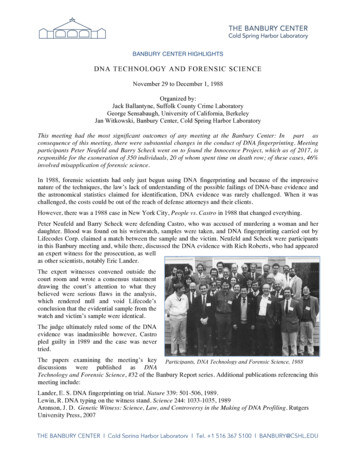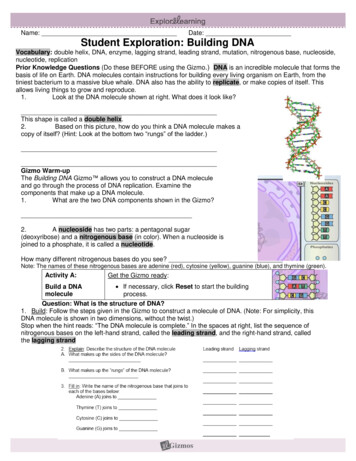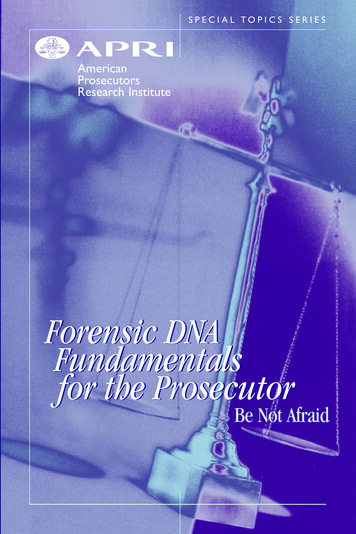
Transcription
S P E C I A L TO P I C S S E R I E SAmericanProsecutorsResearch InstituteForensic DNAFundamentalsfor the ProsecutorBe Not Afraid
American Prosecutors Research Institute99 Canal Center Plaza, Suite 510Alexandria,VA 22314www.ndaa-apri.orgNewman FlanaganPresidentSteven D. DillinghamChief AdministratorDebra WhitcombDirector, Grant Programs and DevelopmentGeorge RossDirector, Grants ManagementThis information is offered for educational purposes only and is not legal advice.This project wassupported by Award No. 2002-DD-BX-0005, from the Bureau of Justice Assistance, U.S.Department of Justice. Points of view or opinions expressed in this document are those of theauthors and do not necessarily represent the official position of the United States Department ofJustice, the Bureau of Justice Assistance, the National District Attorneys Association or theAmerican Prosecutors Research Institute.The American Prosecutors Research Institute is the nonprofit research, training and technicalassistance affiliate of the National District Attorneys Association.
S P E C I A L TO P I C S S E R I E SForensic DNAFundamentalsfor the ProsecutorBe Not AfraidNovember 2003Lisa R. Kreeger, Senior AttorneyDanielle M.Weiss, Staff AttorneyDNA Forensics ProgramAmerican Prosecutors Research Institute
TA B L onThe Science of Nuclear DNADNA and STR TechnologyMitochondrial DNAForensic Identification:The MathDNA Evidence in Criminal Investigation and ProsecutionTrial IssuesAdmissibilityDiscoveryThe Case-in ChiefDefense ExpertsClosing ArgumentConclusionAcknowledgementsAppendix I: GlossaryAppendix II: Resource Listiii
INTRODUCTIONDNA has become an invaluable instrument in the search for justice.DNA evidence may play a significant role at various points throughoutthe life of a criminal case, from the initiation of a criminal investigationthrough post-conviction confirmation of the truth.As the “end users” of DNA evidence, prosecutors must be “in the know.”Understanding DNA, both the science and its technology, is not discretionary, but compulsory to the responsible practice of criminal law.This publication serves as a primer for prosecutors on the basics ofDNA. The application of the science and the math, trial issues andpotential defense challenges that prosecutors face in DNA cases willbe addressed in detail.Never before has material like this been assembled for prosecutors.We hope prosecutors will use this publication to strengthen investigations,find the truth, serve justice and give voice to those who may not have one.1
THE SCIENCE OFNUCLEAR DNAEvery human body is comprised of chemicals whose interactions andsynthesis are regulated by the genetic blueprint that was drawn at themoment of conception. The genetic code determines each person’s individual characteristics and in doing so, dictates that no two persons, withthe exception of identical twins, are the same.The analysis of deoxyribonucleic acid (DNA) began in medical research.1Scientific interest in the DNA structure arose in the early 20th centuryas biochemists began to define the classes of chemicals that comprise usall. Initially, it was discovered that nucleic acids were a major componentof all cellular material. There are two categories of nucleic acids: ribonucleic acid (RNA) and deoxyribonucleic acid (DNA). Later, it waslearned that DNA, rather than RNA, is the repository of the geneticcode. In 1953 James Watson and Francis Crick published their seminalpaper describing the primary structure of DNA.2DNA is a polymer, i.e., a long molecule composed of only a few simpleunits. Those units are deoxyribose (a sugar), phosphate and four (A, C,Tand G) different organic bases. These units taken together arenucleotides, which are the raw building blocks of DNA. The DNAstructure has been likened to that of a long ladder that has been twistedalong its long axis. The sugar and phosphate together form the outsidesupport of the ladder and the four different bases are the rungs or stepsof the ladder. (See Figure 1.)As molecular biology research developed, several scientific truths weredetermined. One premise is that, among human beings, 99.99% of DNAnucleotide sequences are identical. The shared DNA creates humancharacteristics that are similar to all people: two hands, ten toes, bloodthat can be transfused and organs that can be transplanted. The .01% of1 For a summary description of the forensic analysis using DNA, see People v. Axell, (Cal.App. 1991)235 Cal.App.3d 836.2 Watson and Crick, A Structure for Deoxyribose Nucleic Acid, NATURE, April 2, 1953, available h%208/DH-Paper.html.3
FORENSIC DNA FUNDAMENTALSFOR THEPROSECUTORDNA that is not shared is differentin every individual, with only oneexception: Identical twins sharetheir DNA sequence completely.A second premise is that 100% of aperson’s DNA is the same withinand throughout a human being’sbody. Whether you look at the cellsof a person’s blood, skin, semen, saliva or hair, the DNA sequencing willbe the same.3 Scientists have developed a methodology to identify thevariations within an individual’ssequencing, and these methods formthe basis for DNA profiling.Each cell with a nucleus4 contains acopy of a person’s DNA. DNA is amolecule of genetic materials thatencodes a person’s hereditary information. A DNA strand is shaped as aspiral staircase, also referred to as adouble helix. The sides of a DNAstrand are chains of sugars and phosphates. The steps connecting the two Figure 1 (Courtesy of the National Humansides of the staircase are pairs of mol- Genome Research Institute - NIH)ecules called “bases.” There are fourThe double helix is the shape that two pairedbases in the DNA strand: adeninestrands of DNA assume when they are bondedtogether.The double helix is made up of sugars,(A), cytosine (C), guanine (G) andand bases.The bases are adenine,thymine (T). Nucleotides from sepa- phosphatesthymine, cytosine and guanine.rate DNA strands bond in a specificform (the steps), connecting the sides of the DNA (the staircase). C basesbond or pair only with G bases and A bases bond or pair only with T bases.3 There is one very rare exception, a genetic condition that occurs when two fertilized eggs fuse inthe womb, creating a child with two full sets of genes, called a chimera. (David Baron; “DNA TestShed Light on Hybrid Human”, NPR, August 11, 2003). This condition is easily identifiable withlab testing.4 Not all cells have a nucleus, for example, red blood cells do not have nuclei.4A M E R I C A N P RO S E C U TO R S R E S E A R C H I N S T I T U T E
THE SCIENCEOFNUCLEAR DNA(See Figure 2.) There are three billion base pairs, including thirty thousandgenes, which comprise the human genome.The three billion base pairs are grouped in 23 pairs of chromosomes: oneset from the mother and one set from the father (for a total of 46 chromosomes). Specific sequences of bases that code for a characteristic are calledgenes.A gene’s position on a chromosome is its locus. The possiblesequences or variations of a gene are called “alleles.” Because everyoneinherits one set of chromosomes from each parent, humans have two allelesat each locus. Good examples of genes are hair color and eye color: within aperson’s chromosomes, there are genes for hair color and genes for eyecolor. A person’s alleles for hair color may be for brown hair and her allelesfor eye color may be for green eyes—the alleles are the variations of thegene. Genes may be “polymorphic,” meaning they may take different formsor contain different sequences of base pairs. Varying alleles of the genes thatdiffer from one person to another provide the basis for DNA identification.5Figure 2 (Reprinted from: Butler, John M., Forensic DNA Typing, “Additional DNA Markers,”Chapter 2, page 15, Academic Press, 2001, with permission from Elsevier.)A DNA strand is structurally comprised of bases that when paired with other basesform a double helix.The base pairs are held together by hydrogen bonds.5 New Jersey v. Harvey, 151 N.J. 117, 1997 (Supreme Court of NJ).5
FORENSIC DNA FUNDAMENTALSFOR THEPROSECUTORWhen a DNA sample is analyzed, the results are called profiles. Samplescan come from either a crime scene or a person; when analyzed they produce either an evidence profile or a suspect (or known reference) profile.6A M E R I C A N P RO S E C U TO R S R E S E A R C H I N S T I T U T E
DNAANDSTR TECHNOLOGYNuclear DNA is found in blood, sperm, vaginal secretions, mucus,sweat, saliva, hair roots, earwax, bone and teeth. It is found in organs,muscles, and/or skin. Nuclear DNA is found in every cell and tissue ofthe body, except for red blood cells. Also, the DNA found in body fluidscan be in either liquid or dried form. DNA is durable and long lasting.Scientists have progressed in their ability to find DNA suitable for testingin smaller and more degraded samples than ever before. Nonetheless, theauthenticity requirement that ensures the reliability of evidence applies toDNA:The evidence must be what is claimed and not the product ofcorruption or tampering.Historically, scientists needed large evidence samples to enable them toextract DNA. The earliest method of forensic DNA analysis, known asrestriction fragment length polymorphism (RFLP), involved a comparison of lengths of specific DNA fragments. This method required the evidentiary DNA to be relatively non-degraded, a condition not always metby biological material from a crime scene. Also, producing a DNA profile through RFLP analysis requires a great deal of labor, time andexpertise.6 To improve their ability to analyze DNA from a crime scene,scientists developed a method of replicating exact copies of DNA fromthe biological evidence found.7 Their underlying motivation was to produce more samples to enable more testing so that other scientists couldfind the same results obtained by the initial scientist.8 Because of theaccuracy and the durability of the copies, scientists less frequently facethe dilemma of exhausting all of the evidence during analysis. Once thecrime scene evidence is copied, more than one scientist may test it andconfirm accuracy.6 Butler, John M., Forensic DNA Typing, “Overview and History of DNA Typing,” Chapter 1, page 4,Academic Press, 2001.7 In 1993, the inventor of this technique, Dr. Kary Mullis, was awarded the Nobel Prize inChemistry for his discovery.8 National Research Council (NRC-II), The Evaluation of Forensic DNA Evidence, National AcademyPress,Washington DC, 1996.7
FORENSIC DNA FUNDAMENTALSFOR THEPROSECUTORThe amplification/replication process is known as polymerase chain reaction (PCR). PCR allows laboratories to develop DNA profiles fromextremely small samples of biological evidence.9 PCR is a three stepprocess: First, the DNA strand is denatured, which means the strand ispulled apart by heating. Annealing is the second step in the process,where the sample is cooled and the primers bind to the target sequenceof the DNA molecule. (A primer is synthetic or manufactured DNA.)Lastly, the DNA strand is heated again, activating a polymerase (enzyme)that will produce the mate to the single strand to form a complete copy.Each time the PCR process is done, the number of new DNA strandsdoubles, theoretically generating a billion copies after 30 cycles.10 (SeeFigure 3.) The development of PCR was crucial to forensic identification made with DNA because frequently it enables both the prosecutionand the defense to analyze the evidence. It also allows for sample retention if retesting is later deemed necessary.Figure 3 (Reprintedfrom: Butler, John M.,Forensic DNA Typing,“Additional DNAMarkers,” Chapter 4,page 40, AcademicPress, 2001, with permission from Elsevier.)Polymerase ChainReaction—the DNAreplication process.9 National Institute of Justice, Special Report, Using DNA to Solve Cold Cases, PCR Analysis, U.S.Department of Justice; July 2002.10 Butler, John M., Forensic DNA Typing, “The Polymerase Chain Reaction,” Chapter 4, page 39,Academic Press, 2001.8A M E R I C A N P RO S E C U TO R S R E S E A R C H I N S T I T U T E
DNAANDSTR TECHNOLOGYA second significant development in the science of DNA was proficiencyin the testing of short tandem repeats (STR). STR testing is a PCR-basedtechnology. As described earlier, genes are specific sequences of nucleotideslocated at a particular position (locus) on a particular chromosome, and thevariant forms of the genes are called alleles.The different alleles are distinguished either by length polymorphisms or sequence polymorphisms.Short Tandem Repeats or STRs are one type of length polymorphism.STRs are a core sequence of two to seven bases that are repeated consecutively a variable number of times, e.g., ACTGACTGACTGACTG.In the most modern method of DNA profiling, scientists exploit interpersonal genetic variation found in short tandem repeat (STR) sequences.While those repeats are constant in an individual person’s DNA, therepeats vary by individual. Comparing the number of repeats is STRtesting. Taking advantage of PCR technology, STR testing can be performed with smaller and even degraded samples and is the fastest testingtechnology presently available. Slab gel and capillary electrophoresis arethe two separation methods used in the STR process to extract the DNAfor visual analysis and comparison.9
MITOCHONDRIAL DNAThe analysis described up to this point has been based on the geneticprofiling of nuclear DNA, i.e., DNA found in the nucleus of a cell.Another form of DNA that can be used for comparison is mitochondrialDNA (mtDNA), which is found in the mitochondria of a cell, outsidethe nucleus in the cytoplasm. (See Figure 4.) The mitochondria are theenergy source for a cell. MtDNA has 16,569 base pairs and possesses 37genes.11 The portion that is used for analysis is a “non-coding controlregion, also known as the D-loop, which exhibits a fair degree of variation between individuals and is therefore useful for human identity testing purposes”.12 MtDNA can be found in bone, muscle, hair, teeth, skin,blood and body fluids, and like nuclear DNA, it can be located, extractedand copied.Figure 4 (National Institute of Justice, Using DNA to Solve Cold Cases,Washington, D.C.:U.S.Department of Justice, July 2002, p.7.)Cell Diagram: Nucleus, chromosomes and mitochondrion.11 Butler, John M., Forensic DNA Typing, “Additional DNA Markers,” Chapter 8, page 121, AcademicPress, 2001.12 Butler, p.121 (2001).11
FORENSIC DNA FUNDAMENTALSFOR THEPROSECUTORMtDNA can be a great source for analysis in cases where the evidencecollected is so degraded that nuclear DNA analysis would not yield aprofile, for example, cold cases or cases where only skeletal humanremains are found. Two techniques are used to examine mtDNA: PCR,which does the copying, and mitochondrial sequencing, which does thecomparative analysis. Mitochondrial sequencing is a process that looks atthe sequencing of the A, C,T, and G’s, the bases that make up the steps ofthe DNA strand. MtDNA is robust and more plentiful and durable thannuclear DNA. It is, however, less discriminating than nuclear DNAbecause it is transmitted only from a mother to her children and therefore there is less variation between individuals.12A M E R I C A N P RO S E C U TO R S R E S E A R C H I N S T I T U T E
F O R E N S I C I D E N T I F I C AT I O N :T H E M AT HBy using the 1/100% of person-specific DNA, scientists can make spe-cific determinations that have significant forensic value to the prosecutionof a case. First, they can determine the genetic profile drawn from biological evidence found at a crime scene and match it to the genetic profile from a defendant, which would tie this defendant to this chargedcrime. Then, a scientist can calculate the statistical probability that a random unrelated person within the human population would coincidentallyhave the same genetic profile as the one taken from the crime scene evidence. Such a determination helps the prosecutor to meet the burden ofproving that this person committed this crime.When performing forensic DNA testing, analysts first compare the profile generated from the crime scene evidence sample to the profile generated from the offender’s sample. To do this, the analyst examines 13locations along the chromosome, known as loci, which the relevantinternational scientific community has identified as suitable for comparison purposes. Each locus contains two alleles, one from each parent.When the STRs from a crime scene profile match an offender’s profile,it means that there is a match at each and every one of the 26 alleles(genes) that comprise the 13 loci.13,14 The specificity of this forensicidentification is one of the most significant powers of DNA.When scientists compare the crime scene evidence profile and theoffender’s profile, they look for a 100% match of the two profiles at the13 loci. This comparison is not a statistical determination, but rather ascientific one. DNA analysts, however, do speak in terms of statisticalprobabilities when describing the rarity or frequency of finding a certainprofile among human populations.There are approximately six billionpeople on the earth. Comparing DNA at 13 loci can generate a random13 The 13 core loci used for STR comparisons are: TPOX, D3S1358, FGA, D5S818, CSF1PO,D7S820, D8S1179,TH01,VWA, D13S317, D18S51, D21S11, and D16S539. Profiles are alsodeveloped at the Amelogenin locus for sex determination. Currently, Profiler Plus ID andCoFiler typing systems are the kits predominantly used for analysis.14 MtDNA analysis only looks at a single locus, in comparison to the 13 that are looked at fornuclear DNA analysis.13
FORENSIC DNA FUNDAMENTALSFOR THEPROSECUTORmatch probability greater than six billion. In other words, the analyst maytestify that there is no likelihood that anyone else, other than theoffender, will have the same genetic profile as the profile generated fromboth the crime scene evidence and the offender. By calculating the random match probability, scientists can conclude from whom the DNAoriginated, also called source attribution of the DNA. In other words, thesestatistical formulae allow the analyst to demonstrate, using 13 loci inSTR testing, that an individual profile matching the profile generatedfrom the crime evidence will not be found in any other unrelated person on earth.The product rule is the statistical method used to calculate the randommatch probability. The product rule states as follows:When events areindependent, then the frequency of their combined occurrence may bedetermined by multiplying the individual frequency of an occurrence byone another. For example, think of a single playing card and a full deckof cards. The likelihood (or frequency of occurrence) of selecting thetwo of hearts from a deck on one try is 1:52. The likelihood (or frequency of occurrence) of selecting it from one deck and then selectingthe same card from a second deck is 1:52 times 1:52, or 1:2,704. And,since each of the 52 cards is different, the likelihood of selecting a two ofhearts and then the queen of spades from the same deck is 1:52 times1:51, or 1: 2,652. Applying this rule to the likelihood of locating thesame genetic profile, the product rule is translated as follows:The frequency of occurrence of the alleles found at one locus is multiplied bythe frequency of occurrence of the alleles found at a second locus, whichis multiplied by the frequency of occurrences of all the other alleles inthe remaining 11 loci.15 The total random match probability is the probability of that exact genetic profile being found in someone, other than thesuspect, within the human population.1615 In order to take advantage of the product rule, STR markers used in forensic typing were chosento insure independence. In other words, the inheritance of a profile at one location does notinfluence the inheritance of a particular profile at any other locations.16 The Federal Bureau of Investigations (FBI) has determined frequency of allelic occurrences at thedifferent loci in a number of human populations. For reporting purposes, however, the FBI usesthe four most common populations: Caucasians, African Americans, Southwestern Hispanics andSoutheastern Hispanics.14A M E R I C A N P RO S E C U TO R S R E S E A R C H I N S T I T U T E
F O R E N S I C I D E N T I F I C AT I O N : T H E M AT HThe negative, or absence of the profile being found amongst others, is avery important distinction to make. In the forensic identification of anoffender, the analyst discusses probabilities. The analyst is not saying theoffender’s profile is the only one of its kind in existence, simply becausenot every person on earth has been DNA profiled, so a direct comparison to all human DNA is impossible. Instead, there can only be an estimate of the probability of finding the same profile among all possiblearithmetic combinations.Prosecutors, defense attorneys, and judges frequently make mistakes intheir translations or descriptions of the statistical frequencies. Theseerrors can result in misstatements of fact, mistrials, or worse, miscarriagesof justice. In answer to the question, “What is the chance of a coincidental DNA match?” one common erroneous statement is, “The numbers mean there is only a million to one chance the DNA came fromsomeone else.” A correct statement would be, “The statistical frequencythat the evidence profile will be found in a population of unrelated individuals is one time in ‘X’ billion or quadrillion.” Another fallacy is,“Anyone else with the same profile has an equal chance of having committed the crime.” Assuming the statement could be used in a situationinvolving identical twins, an evaluation of all of the evidence and itsapplicability to each twin would significantly alter the equality of chance.Obviously, and importantly, the random match probability regarding theDNA evidence in no way projects odds or likelihood of guilt.15
DNA EVIDENCE INC R I M I N A L I N V E S T I G AT I O NAND PROSECUTIONIn addition to proving identity, DNA evidence can prove and/or corrob-orate other elements of substantive crimes such as sexual battery, burglary,robbery, or homicide. Its constraints are only limited by a prosecutor’s creativity. In proving all of the elements of a crime, all the questions of who,what, when, where, and sometimes, why, must be answered. Extrapolatingmeaning from the source, location and type17 of DNA evidence foundduring an investigation can help answer these questions.Where was the DNA sample found? Assume, for example, that a DNAsample, blood, is recovered from gravel in the victim’s driveway.This evidence may corroborate the victim’s description of being assaulted in herdriveway. Or, if a DNA sample matching a victim is found in a defendant’s home, this evidence can refute the defendant’s claim that the victim was never there and help to prove where the crime occurred.DNA evidence can also help determine what happened during a crime.Fingernail scrapings of only the victim’s skin under the victim’s fingernails, combined with scratches along his neck, may illustrate or corroborate the victim’s attempt to remove a ligature or human hands fromaround his throat. As another example, saliva samples found under a bedmay indicate that a victim was hiding there before she was discovered.The location of DNA samples can also help demonstrate a sequence ofevents, or when a specific incident occurred. For example, identifying asingle DNA source from blood spots on an outside wall but a mixture ofsources from blood on an inside wall may support a theory that an incident began outdoors before escalating to mutual combat and justifiableforce indoors. Finding a victim’s DNA in a blood sample taken fromthe defendant’s weapon could help explain why the victim acceded to thedefendant’s demands.17 Type means single human source, human mixture or non-human DNA.17
FORENSIC DNA FUNDAMENTALSFOR THEPROSECUTORDNA evidence can even help demonstrate purpose or intent. For example, DNA evidence taken from the inside of a ski mask arguably indicatesthe intent to commit the crime—in certain circumstances, finding, takingand wearing a ski mask must have been purposeful behavior. Finding amixture of a defendant’s blood and a victim’s blood on a victim’s towelrecovered from a garbage can may demonstrate the defendant’s purposeful conduct of removing and concealing evidence. DNA evidence foundinside a burglary victim’s home is similar to fingerprint evidence – consistent with the absence of consent when the homeowner does not knowthe person who left the sample.DNA evidence may also be used to impeach a defendant’s description ofevents. For example, in sexual assault cases, defendants frequently denyeven knowing the victim. Confronted with his DNA found in the victim’s vagina, the defense theory quickly shifts to one of consent. DNAevidence can also enhance a witness’s credibility. DNA evidence fromthe defendant, recovered from an article of clothing described by thewitness, bolsters the accuracy of the witness’s initial description.In sum, DNA’s evidentiary value can go far beyond proving the defendant’s identity. DNA evidence should be used just as any other form ortype of evidence—to corroborate, validate and/or impeach evidence ortestimony.18A M E R I C A N P RO S E C U TO R S R E S E A R C H I N S T I T U T E
TRIAL ISSUESThe trial issues of concern to prosecutors are admissibility, discovery,case presentation, defense attacks, and proper closing argument. The sections to follow will discuss these topics in detail.AdmissibilityUnderstanding DNA testing and DNA forensic identification is essentialto arguing its admissibility. Fortunately, admissibility battles have beenwon in both courthouses and statehouses for the past 15 years.18Thirteen states have statutes specifically authorizing admission of DNAevidence.19 Through case law, more than 35 states have admitted intoevidence the PCR method of copying or amplifying DNA; more than30 have admitted into evidence the results of STR testing; more than 25states have admitted into evidence population frequency data or statistics;and more than 11 states have admitted mitochondrial DNA evidence.In those states where DNA evidence has not been admitted, either oneof two standards, or a hybrid of the two, must be met in order for theadmission to be legally sufficient. One standard is that articulated in Fryev. United States, 293 F. 1013 (D.C.Cir. 1923). The other standard is thatarticulated in Daubert Merrill Dow Pharmaceuticals, Inc., 509 U.S. 579, 113S.Ct. 2786, 125 L.Ed.2d 469 (1993). Occasionally, a jurisdiction will usea variant derived from the cases or state statute, as in the ColoradoCriminal Rules of Evidence 702 and 403. The Frye standard requiresthat the scientific evidence offered has been generally accepted by thescientific community to which it relates and that the testing proceduresused properly applied the scientific technique. The Daubert standardrequires a demonstration of the validity of the underlying scientific theory, the reliability of the scientific test, and the usefulness of the scientificevidence to the jury.18 Andrews v. State, 533 S.2d 841 (3rd DCA 1988).19 For case or statute listings by technology and jurisdiction, contact APRI.19
FORENSIC DNA FUNDAMENTALSFOR THEPROSECUTORGenerally, admissibility standards are met through the testimonial or documentary evidence specific to the case, the pertinent scientific literatureand all the authority from other jurisdictions throughout the country.Because the requisite evidence may be introduced in documentary form,and because DNA evidence—be it RFLP or STR—has been admitted inthe majority of the country, an argument can be made that a hearing isunnecessary. To date, mitochondrial DNA has been admitted in 11 statesand the same is true—many admissibility issues have been litigated.Thegoal is to limit the admissibility hearing by persuading the court of thedegree to which the scientific and legal communities have accepted thescientific and mathematical methods that serve as the basis for DNA testing and forensic identification.DiscoveryIntegral to the legal sufficiency of the discovery in a case is the communication and coordination between the laboratory analyst, the prosecutor,and law enforcement. A prosecutor must meet two responsibilities: compliance with criminal procedure and ethical rules. Generally, the factssubject to appellate review in pretrial discovery matters are: (1) factsdescribing the State’s efforts to make available scientific test reports andrelevant raw data used in a given case, and (2) facts describing the State’sefforts to maintain and preserve the evidence.20To ensure criminal procedure compliance, it may be useful for prosecutorsto work with the laboratory to coordinate a generic discovery response,independent of a specific case. Subsequently, the prosecutor may supplythe discovery, or parts thereof, and confidently invite the defense attorneyto visit the lab, at the mutual convenience of the analyst and the attorney,to obtain copies of discoverable materials that are specifically available.The prosecutor’s ethical responsibilities pertaining to biological evidenceare (1) to preserve evidence that possesses both an apparent exculpatoryvalue and that cannot be obtained by other reasonably available means,2120 Arizona v.Youngblood, 488 U.S. 51, 102 L.Ed.2d 281, 109 S. Ct. 333 (1988).21 California v.Trombetta, 467 U.S. 479, 81 L.Ed.2d 413, 104 S.Ct. 2528 (1984), citing Brady v.Maryland, 373 U.S. 83, 10 L.Ed.2d 215, 83 S.Ct. 1194 (1962).20A M E R I C A N P RO S E C U TO R S R E S E A R C H I N S T I T U T E
TRIAL ISSUESand (2) to ensure that the defendant has access to the “basic tools” or“raw materials integral to the building of an effective defense.”22 Thebest practice for successful discov
6 Butler,John M.,Forensic DNA Typing,"Overview and History of DNA Typing," Chapter 1,page 4, Academic Press,2001. 7 In 1993,the inventor of this technique,Dr.Kary Mullis,was awarded the Nobel Prize in Chemistry for his discovery. 8 National Research Council (NRC-II),The Evaluation of Forensic DNA Evidence,National Academy Press,Washington .

